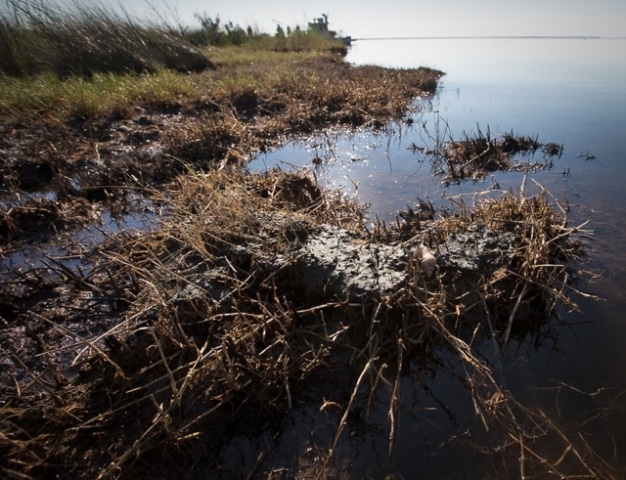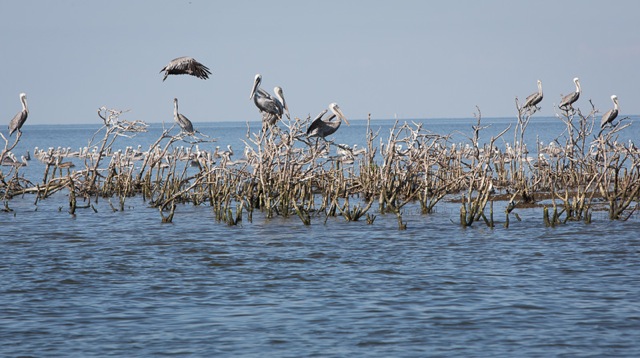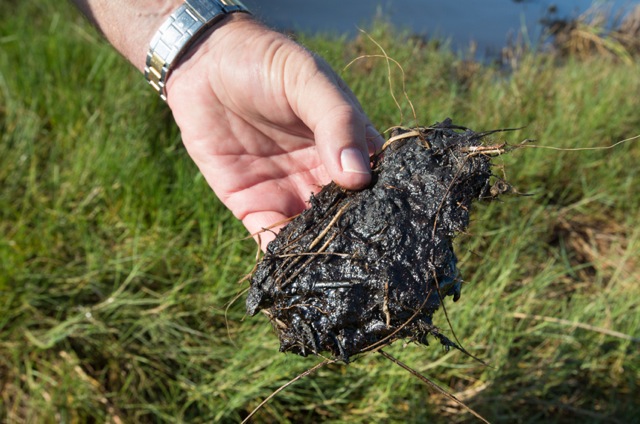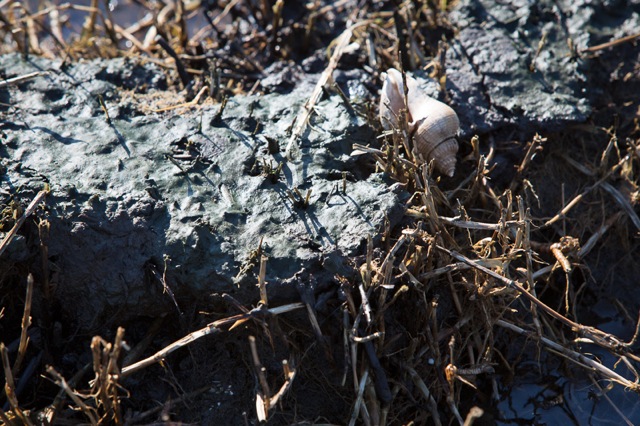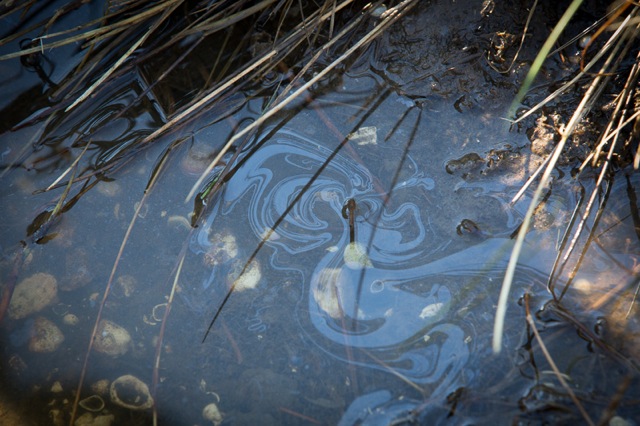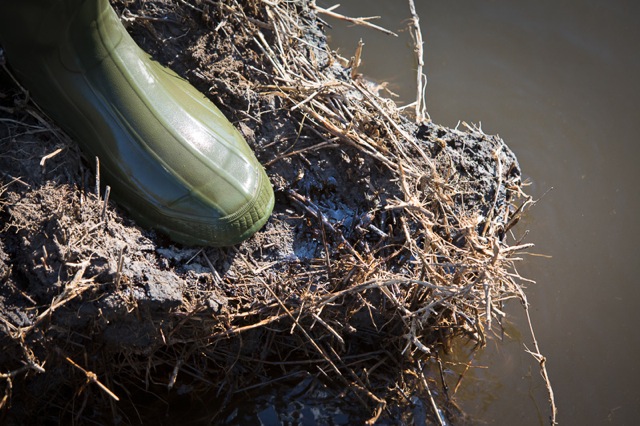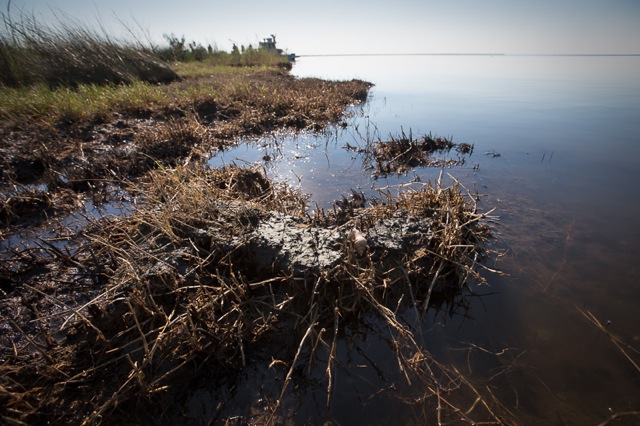The toxic mess left in the wake of the BP Deepwater Horizon oil disaster continues to negatively impact Gulf Coast ecosystems as the second phase of the BP trial begins in New Orleans.
Billions of dollars are on the line in the trial following the explosion of the Macondo well that took 11 lives and damaged the Gulf Coast’s economic and environmental health.
On September 27th, Plaquemines Parish Coastal Zone Director P.J. Hahn took a trip to survey some of the areas most devastated by the oil spill, including Bay Jimmy and Cat Bay. Oil remains in the marsh, and coastal erosion continues at an accelerated rate.
Coastal erosion, a major environmental challenge even before the spill, became a bigger problem when oil washed onto the barrier islands, killing the roots of marsh grass and mangrove trees that helped to hold the land together.
Since the spill, Hahn has been documenting two barrier islands in Cat Bay that had active bird rookeries. The rookeries had been host to spoon bills, egrets and brown pelicans, the Louisiana state bird that only recently was taken off the endangered species list.
When oil hit Cat Bay’s shores, Hahn watched helplessly as many birds were coated in oil and nests were trampled by cleanup workers. The first two years after the spill, the birds returned to nest despite the island’s shrinking geography. But this year, the birds have not returned because the mangrove trees where they build their nests were all but dead. On the 27th, Hahn found birds congregating on the remaining dead mangrove tree branches, but the island was just about gone.
Barrier Island in Cat Bay known as Cat Island, June 16, 2012
Barrier Island in Cat Bay known as Cat Island, September 27, 2013
Rebuilding these islands is not part of Louisiana’s master plan for coastal restoration, a plan that will utilize money from the BP oil settlement. So Hahn started a campaign to save the islands and raise funds independently.
Last year, Hahn obtained the permits needed to rebuild the islands. He helped raise $3 million, but needs an additional $11 million to renew both islands. He has scaled back the project in the hope of saving at least one of the islands, which can be done if he can raise an additional $1.5 million. Donations have come from Plaquemines Parish, the American Bird Conservancy, the federal Coastal Impact Assistance Program and Shell Oil.
As erosion continues to devour the island, the project becomes less viable and more costly. “It would be great to see BP step up and donate the money. From a PR stand point, this would be a ‘no brainer’ for BP since they continue to tout themselves as ‘making it right’ along the Gulf. After all, Cat Islands were ground zero to the oil spill,” Hahn says.
Plaquemines Parish Coastal Zone Director P.J. Hahn holds a tar ball found in the marsh along Bay Jimmy’s banks
New studies on the BP spill shed light on the toxic effects of spilled oil and the dispersant Corexit. LSU AgCenter entomologist Linda Hopper Bui has been researching the spill’s impact on insects in the marsh and has documented their dwindling population.
A new report on cleanup workers’ health conducted by the University Cancer and Diagnostic Centers in Houston, Texas, shows that workers experienced significantly altered blood profiles, liver enzymes, and somatic symptoms.
Another study that is part of the Natural Resource Damage Assessment shows the damage done to marine life on the Gulf’s floor is worse than originally thought. The damage to sea floor life extends at least 57 miles from the source of the spill, and it could take the sea floor a generation to recover.
BP challenges the results of these studies. They have also repeatedly challenged the claims process, a process they helped design and signed off on. In the second phase of the BP trial, the defense is contesting how much oil was spilled and has defined the job they did capping the well as adequate, despite the ruinous 87 days it took for them to do so.
Judge Carl Barbier of the United States District Court for the Eastern District of Louisiana, is tasked with deciding if BP and its partners acted with gross negligence or willful misconduct. The government claims that 4.2 million barrels spilled, while BP claims it was a mere 2.45 million barrels.
According to the Times-Picayune, “BP‘s estimate would result in maximum fines of $2.7 billion for simple negligence, or $10.5 billion if the company committed gross negligence. In contrast, the government’s estimate would result in maximum fines of $4.6 billion for simple negligence or $18 billion for gross negligence.”
Also at issue is whether BP did all it could to cap the well in a timely manner, as required by the Clean Water Act.
Onetime BP partners Transocean and Halliburton are working with the plaintiff steering committee to show that if BP hadn’t misled the government about the spill’s flow rate, the well would have been shut off as early as May.
The first attempt to cap the well with a ‘top hat’ was destined to fail since the spill rate was higher than disclosed. They argue that if the actual flow rate had been disclosed, a ‘capping stack’ would have been insisted upon, the solution that was used to eventually stop the flow in July. BP will counter the accusation with the National Incident Commander Thad Allan’s remarks. Allan has testified that it is impossible to predict whether access to a pre-built capping stack would have shortened the time needed to close the Macondo well.
The BP oil spill combined with the dumping of millions of gallons of Corexit dispersant into the Gulf of Mexico has turned the Gulf into a giant petri dish.
The first round of scientific testing indicates that things will get worse with time, as was the case after the Exxon Valdez spill in Alaska.
BP‘s television commercials continue to claim things along the coast are better than ever. Their latest campaign alleges fraudulent claims have turned BP into a victim. The commercials are a constant sore spot for the real victims of the spill whose lives are in limbo as BP opts to litigate rather than come to an acceptable settlement.
Despite BP’s jaunty sloganeering, it is difficult to point out anything that has been made right by them.
Oil coats the top of the marsh along Bay Jimmy’s banks
Sheen washes off the hardened oil that coats the marsh along the banks of Bay Jimmy
Oil coats the top of the marsh along Bay Jimmy’s banks
Oil coats the top of the marsh along Bay Jimmy’s banks
Images and video © 2013 Julie Dermansky
Subscribe to our newsletter
Stay up to date with DeSmog news and alerts


